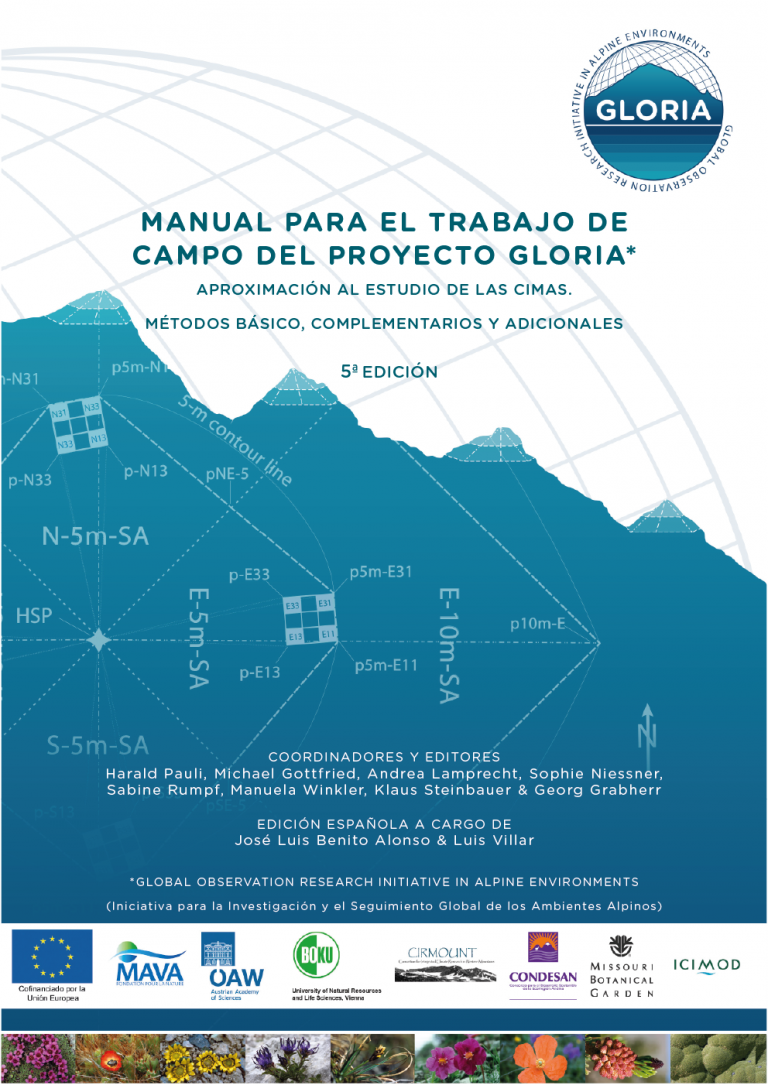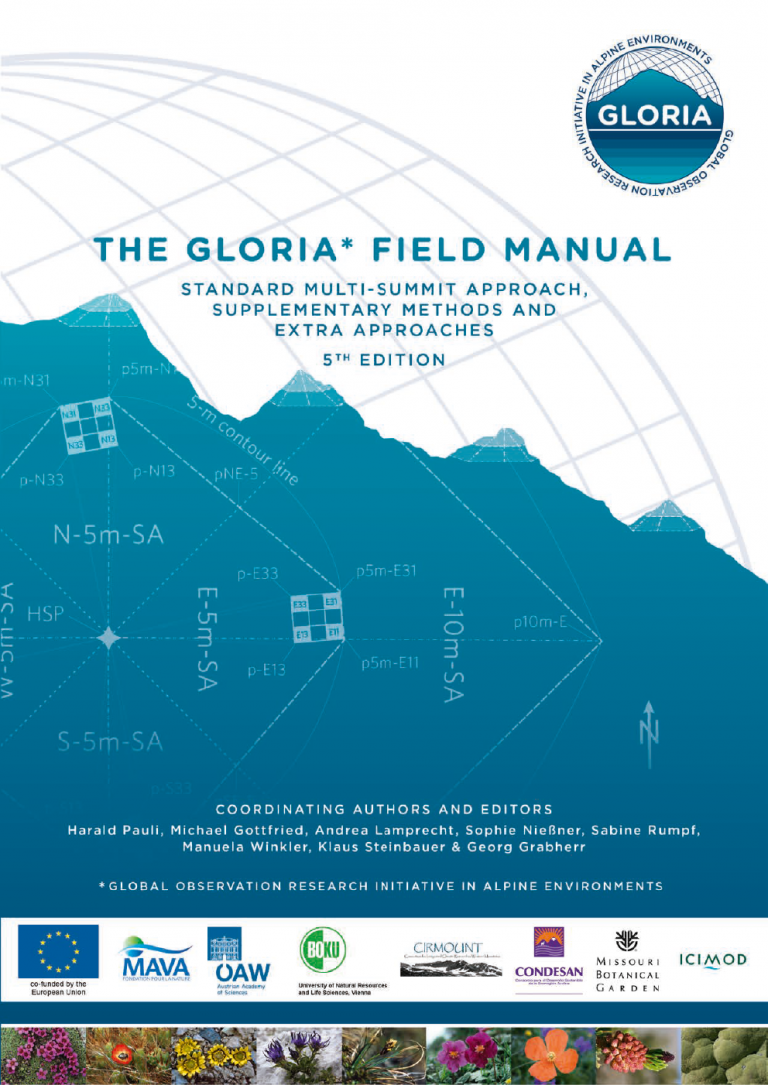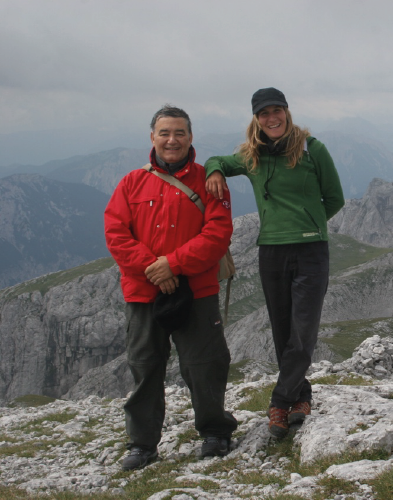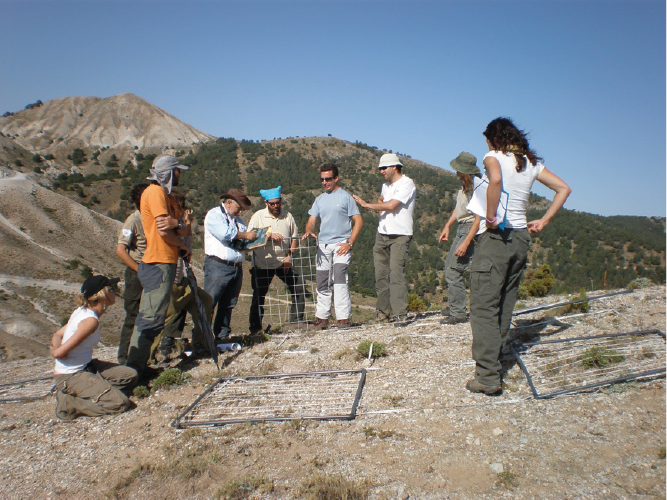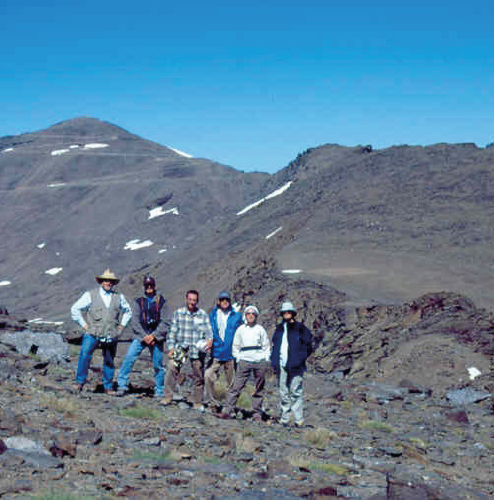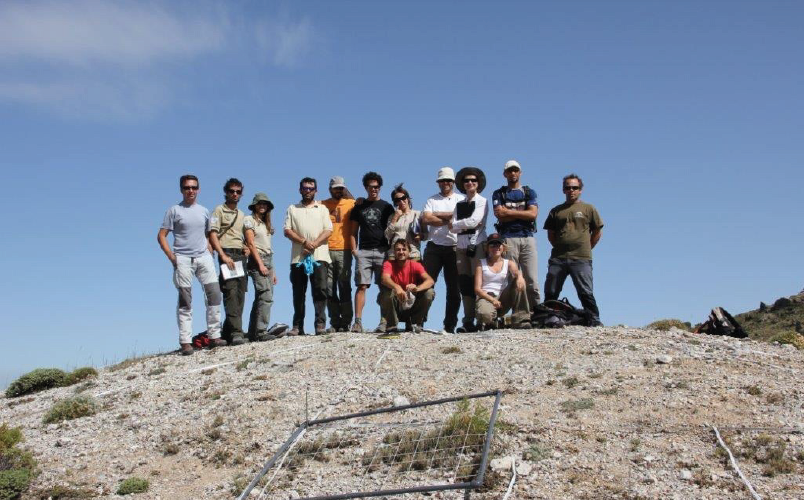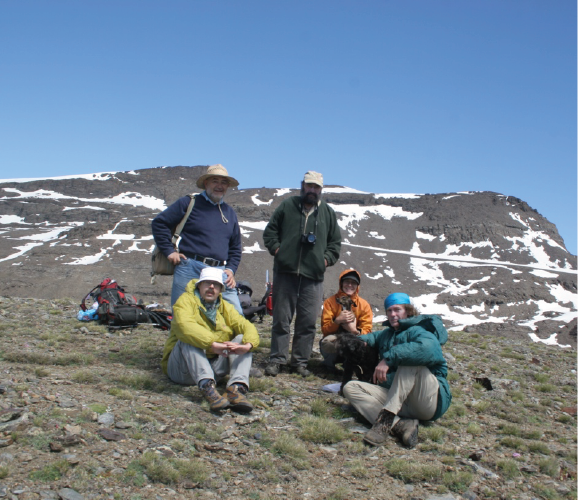What is GLORIA
It is a program for monitoring global change in alpine environments (Global observation Initiative in Alpine Environments; GLORIA). It is a long-term monitoring based on a network of sampling points at a global level.
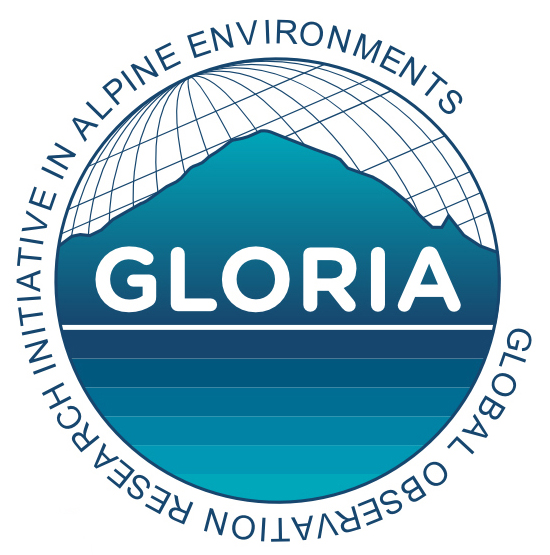
This monitoring program started in 2001 in 18 European mountain ranges (GLORIA-Europe), including Sierra NevadaIt has now spread to mountains around the world, bringing together more than 121 study areas in the main mountain ranges of all biomes, from the poles to the tropics (GLORIA-Worldwide).
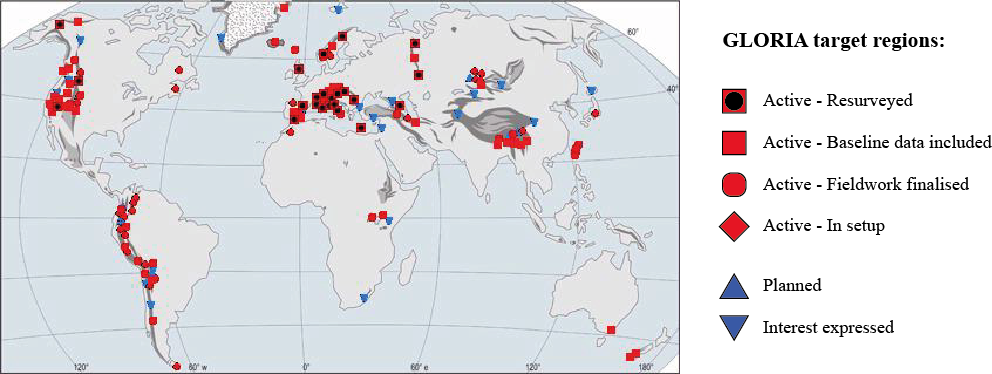
GLORIA focuses its attention on the alpine biozone (i.e., high mountain areas), defined as the area above the level where low temperatures condition the absence of forest (forestline; including the ecotone constituted by the upper limit of the trees (treeline), plus the alpine and snow levels.treeline), más los niveles alpino y nival.
Target
Assess the impacts of climate change on high mountain plant biodiversity globally.
History
In 2001, Georg Grabherr, Michael Gottfried, and Harald Pauli (Department of Integrative Biology and Biodiversity Research, University of Natural Resources and Life Sciences, Vienna, Austria), launch GLORIA-Europe with 18 sites in 13 European countries. Since 2004, the project has expanded and today almost all mountains in the world are represented.
There are six active GLORIA monitoring areas in Spain:
- Aragonese Pyrenees ES-CPY-Ordesa and Monte Perdido National Park (2001) and ES-SPY-Pirineo Silíceo-Valle de Tena (2001).
- Sierra Nevada National Park: ES-SNE-Western Sierra Nevada (2001) and ES-SNN-North Eastern Sierra Nevada (2004).
- Central System: ES-SIC-Navacerrada (2006).
- Cantabrian Mountains: ES-CRE-Cantabrian Mountains: (2010).
- Iberian System: ES-MON-Moncayo (2012).
It is the European country that contributes the most areas to the GLORIA network.
Sampling Methodology
At the 2010 GLORIA Project conference in Perth, Scotland, about 100 project members discussed and worked on the results obtained so far, and the result was a field manual, available in several languages.
The sampling adopted for this monitoring network is replicable, simple and economical. It is based on a "multi-summit approach", with the following characteristics:
Each study area (target region) is characterized by:
- 4 peaks designated for monitoring.
- Located in an altitudinal gradient.
- Located in the same region and with the same geological substrate.
- Establishment of permanent plots in which a standardized sampling of the vegetation is done every 5-10 years.
- Continuous recording of the floor temperature (1 recording every hour x 4 temperature sensors x peak)
The activities for each sampling are:
Mandatory activities
- Registration of the species (vascular plants) in 16 quadrats of 1×1 m.
- Semi-quantitative record of species in 8 areas of each summit.
- Photographic documentation of plots.
- Continuous floor temperature recording.
Optional Activities
- Record bryophytes, lichens and additional quantitative vegetation estimates.
GLORIA in Sierra Nevada
The GLORIA project has two target regions in Sierra Nevada. Currently the scientific responsible is Dr. Juan Lorite, Department of Botany, UGR. Previously (2001-2019) the scientific coordination was in charge of Dr. Joaquin Molero.
- Target region SNE: 4 peaks. Sampling since 2001 (2001-2008-2015-2022)
- Target region SNN: 4 peaks. Sampling since 2004 (2004-2011-2019-2026)
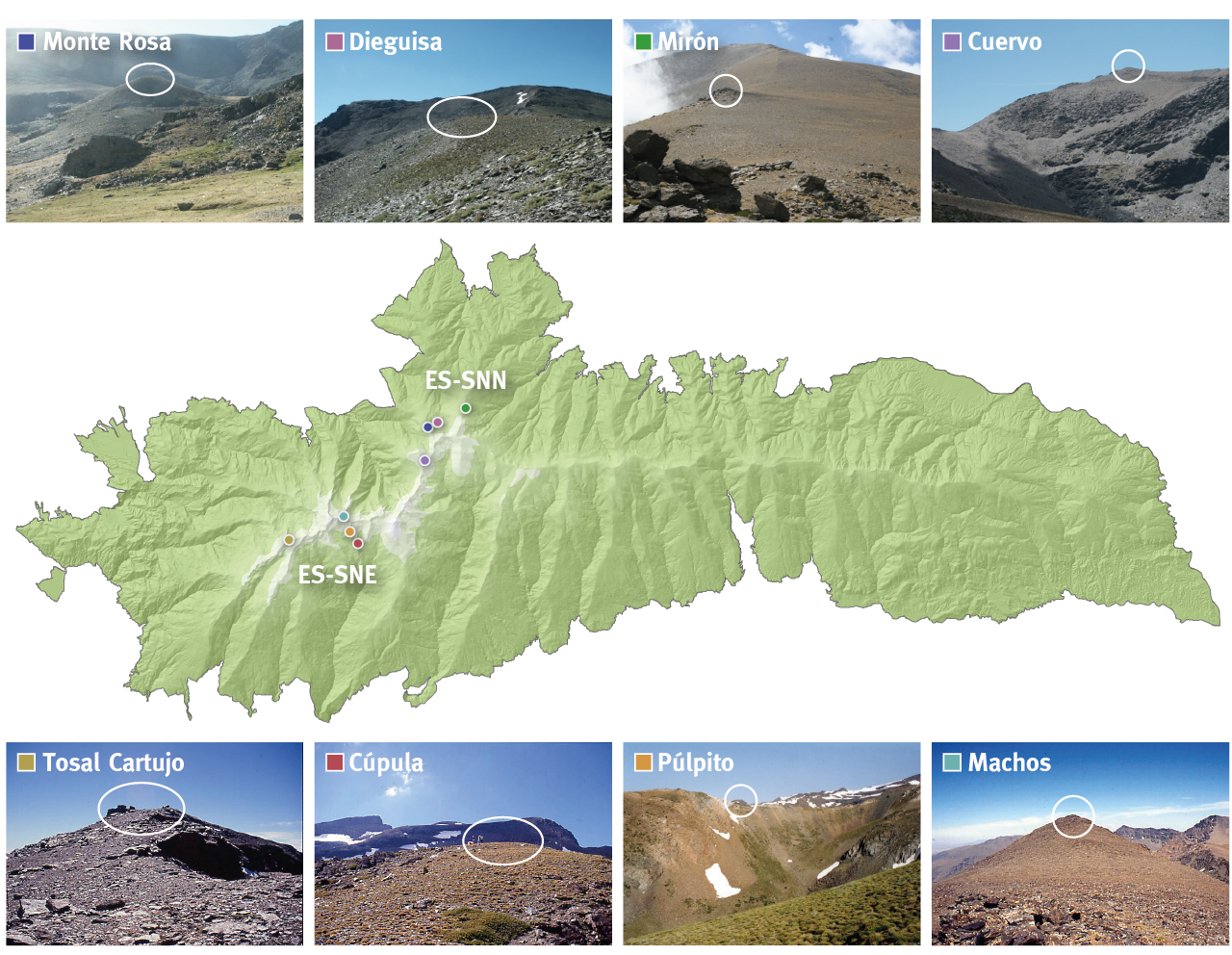
Financing of the GLORIA Project in Sierra Nevada
In 2001 the core group of researchers leading the GLORIA Project, Georg Grabherr, Michael Gottfried and Harald Pauli (Department of Integrative Biology and Biodiversity Research, University of Natural Resources and Life Sciences, Vienna, Austria), in collaboration with the group of the University of Granada led by Joaquín Molero, established the first 4 monitoring plots in four summits (Sierra Nevada Oeste-SNE) and carried out the first sampling of the time series. All this with the financial support of the Project GLORIA-Europe, financiado por el Quinto Programa Marco de Investigación de la Unión Europea.
In 2004Joaquin Molero's team started the research project: "Climate change in the Sierra Nevada from phytogenic scenarios, species and plant communities indicators and the evaluation of the biological activity of soils in the cryo-Mediterranean floor (cycles of C and N)"funded by the Research Program in the National Parks Network (OAPN). With it, four other monitoring plots were installed (Sierra Nevada Noroeste-SNN), where, in addition to basic sampling, a monitoring of lichen flora and soil C and N cycles was carried out. This installation and follow-up also had the financial support of the GLOCHAMORE project (Global Change in Mountain Regions: An Integrated Assessment of Causes and Consequences).
In 2009 a period of collaboration began between the team led by Dr. Molero with the Sierra Nevada Global Change Observatory, financed through a contract signed between the University of Granada and the former EGAMSA (now the Environment and Water Agency). This contract financed the training of personnel, the management of data from monitoring and its publication.
Between 2015 and 2019, the MEDIALPS, project, funded by the Austrian Academy of Sciences and led by Dr. Manuela Winkler (Department of Integrative Biology and Biodiversity Research, University of Natural Resources and Life Sciences, Vienna, Austria) expanded the spectrum of knowledge. In addition to the monitoring of vegetation and soil temperature, other ecological and ecophysiological variables were added.
Throughout this process, the Environmental and Regional Planning Council of the Regional Government of Andalusia has strongly supported the GLORIA project, facilitating and actively collaborating in the field work from Sierra Nevada National and Natural Park. The Environment and Water Agency, as an instrumental entity of the Regional Council, in addition to providing technical support for data collection, has provided part of the material means and participates in the analysis of the results, which are periodically incorporated into the Observatory databases.
Work team in Sierra Nevada
As mentioned above, the GLORIA project began in 2001 in Sierra Nevada. Between 2001 and 2018, Drs. Joaquín Molero and Abderrahmane Merzouki, from the Department of Botany of the University of Granada, acted as scientific leaders. From 2018 to the present, the scientific responsible is Dr. Juan Lorite.
Between 2001 and the present day, many researchers, students, technicians and environmental agents have collaborated in the periodic data collection at these peaks. We hope not to forget any of the participants, since without their invaluable help it would not have been possible to carry out these samplings:
UGR RESEARCHERS AND STUDENTS
Joaquín Molero Mesa, Abderrahmane Merzouki , Mª Rosa Fernández Calzado, Juan Lorite Moreno, Fabián Mesa Millán, Diego Nieto Lugilde , María Eugenia Ramos Font , Cristina Patricia Sánchez Rojas, Juan José Jiménez González , José Manuel Sánchez Robles , Santiago Schiaffino Ortega, José Manuel Ramiro Gutiérrez , Guillermo Benítez Cruz, John Blanco Houston , José Miguel Romero Molina, José Miguel Marfil, Álvaro López García, Manuel Casares Porcel, Mª Reyes González-Tejero García, Mª Isabel de Haro Bravo , El Mesbahi Mohamed Najib , Samir Benghazi Akhlaki , Cristina Bonillo García, Daniel Álvarez Yaque, Julia Molero, Katy Rondinel, Salvatore Cambria, Sorboni Karimzoda, Patricia González Díaz, Jenaro Leal, Marina Morente, Nuria Ibáñez, Susana Ortiz Sanz, Ana González Robles
ENVIRONMENTAL AND REGIONAL PLANNING COUNCIL OF THE REGIONAL GOVERNMENT OF ANDALUSIA
Daniel Morillas Fernández, José Pedro Sánchez Martínez, Juan Reyes Moreno, Manuel Román Sánchez
ENVIRONMENT AND WATER AGENCY
Mario Ruiz Girela, Cristina Patricia Sánchez Rojas, José Miguel Muñoz , Antonio Veredas Navarro , Gonzalo Muñoz Pedraza, Juan de Dios Rodríguez Cáceres, Miguel Ángel Arrufat Jiménez, Mónica Martínez Villalba , Rogelio López Sanjuan
Results
- Important changes in the composition in 7 years Scrubbing of the peaks.
- Increase in species richness in temperate climate and decrease in Mediterranean mountains such as Sierra Nevada.
- Reduction of species adapted to "cold" and replacement by less adapted species: thermophilization.
- Decline of mountain habitats and species
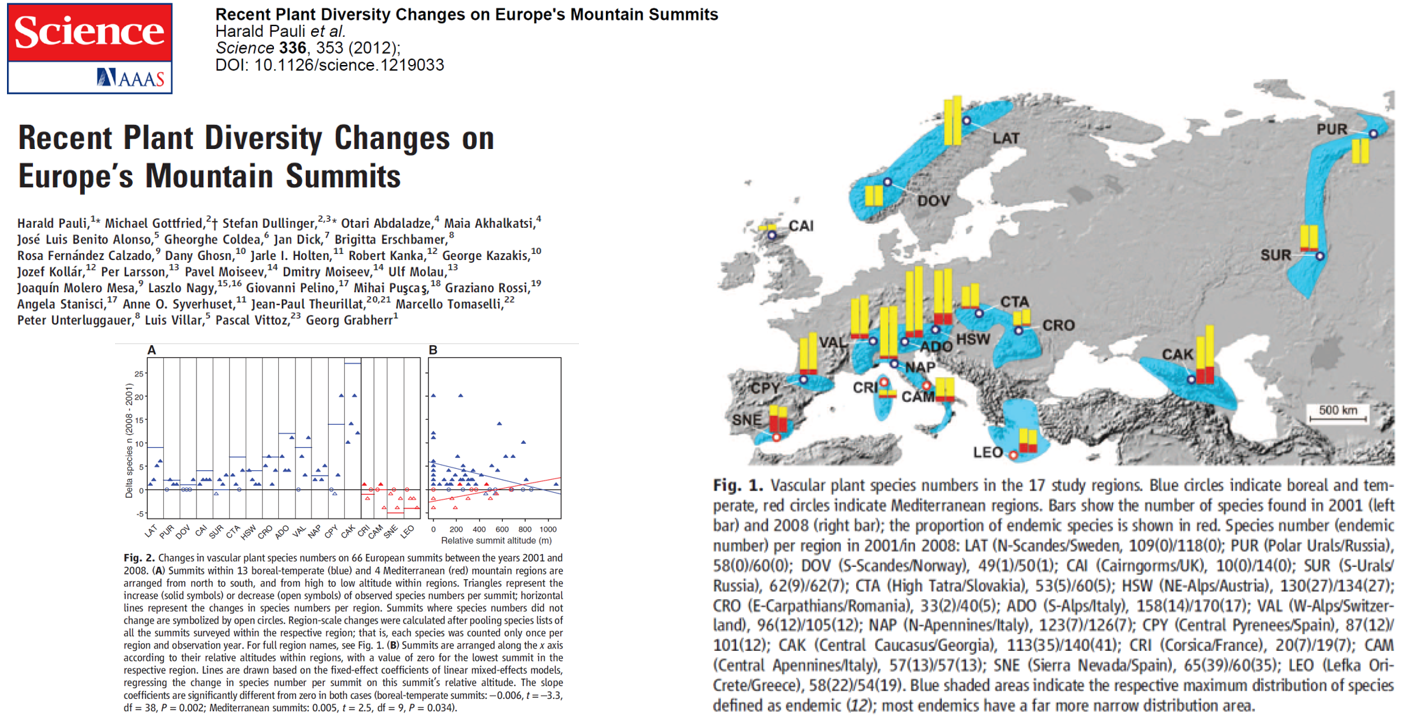
Works in progress
- SoilTemp: call for data for a global database of soil temperature. Lembrecht et al. (en revisión)
- Automated vegetation cover estimation from close-range photogrammetric point clouds in alpine terrain for interpretation of micro-topographicconditions in summit areas of the Alps and Mediterranean mountains. Niederheriser et al. (en revisión)
- Changes in alpine vegetation in the southermost limit of european mountains (Sierra Nevada SE Spain) (en preparación).
References
Fernández Calzado, M.R. & Molero Mesa, J. (2013). Changes in the summit flora of a Mediterranean mountain (Sierra Nevada, Spain) as a possible effect of climate change. Lazaroa 34: 65-75.
Fernández Calzado, M.R. & J. Molero Mesa, J. (2011). Indicios del impacto del clima en la flora de Sierra Nevada. Quercus 308: 60-61.
Fernández Calzado, M.R., Molero Mesa, J. & Merzouki A. (2010). Monitoring plant diversity and climate change in Sierra Nevada (Spain). Acta Botánica Gallica 157 (4): 669-676.
Fernández Calzado, M.R., Molero Mesa, J., Merzouki, A. & Casares Porcel M. (2012). Vascular plant diversity and climate change in the upper zone of Sierra Nevada, Spain. Plant biosystems 146(4): 1044-1053.
Fernández Calzado, M.R. & Molero Mesa J. (2011). Historical evidences on flora composition changes in a high vegetation belt, Sierra Nevada, Spain (1837-2009). Int J Geobot Res 1:41–54. https://doi.org/10.5616/ijgr110003
Gottfried M, Pauli H, Futschik A, et al (2012) Continent-wide response of mountain vegetation to climate change. Nat Clim Chang 2:111–115. https://doi.org/10.1038/nclimate1329
Molero Mesa J., Fernández Calzado, M. R., Merzouki, A., Casares Porcel, M. y González-Tejero M.R. (2009). Escenarios fitocenológicos de observación para el seguimiento del cambio climático en Sierra Nevada. Monografía de investigación Parques Nacionales: 73-96.
Molero-Mesa J, Fernández-Calzado M.R. (2010) Evolution of the high mountain flora of Sierra Nevada (1837-2009). Acta Bot Gall 157:659–667. https://doi.org/10.1080/12538078.2010.10516239
Pauli H, Gottfried M, Dullinger S, et al. (2012). Recent Plant Diversity Changes on Europe’s Mountain Summits. Science (80) 336: 353–355. https://doi.org/DOI 10.1126/science.1219033
